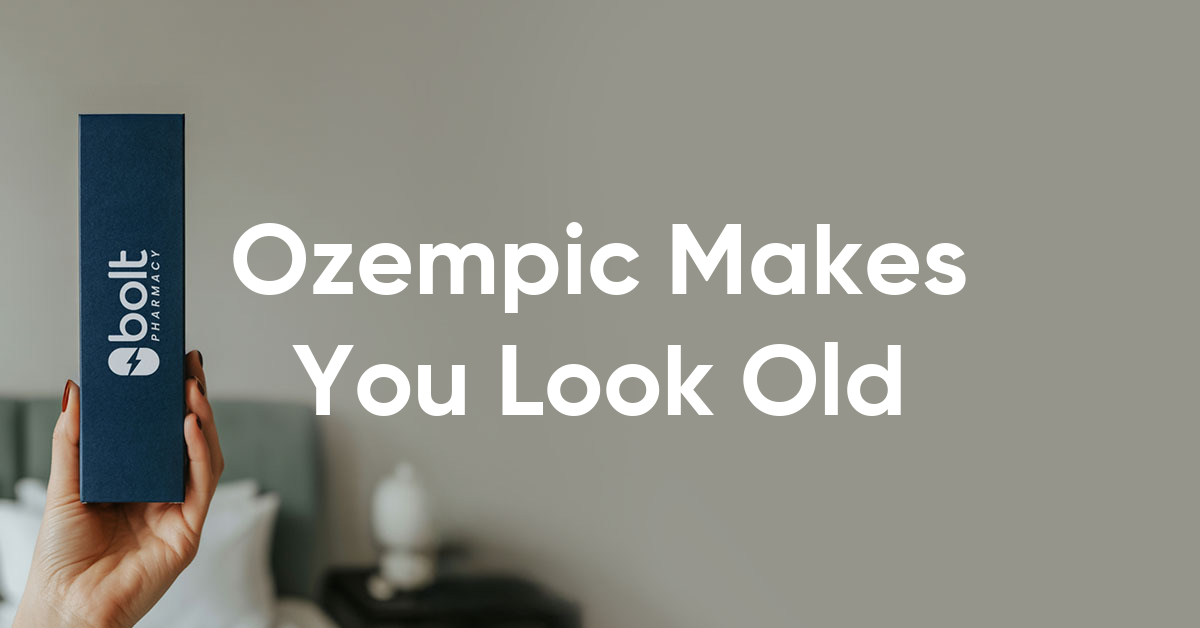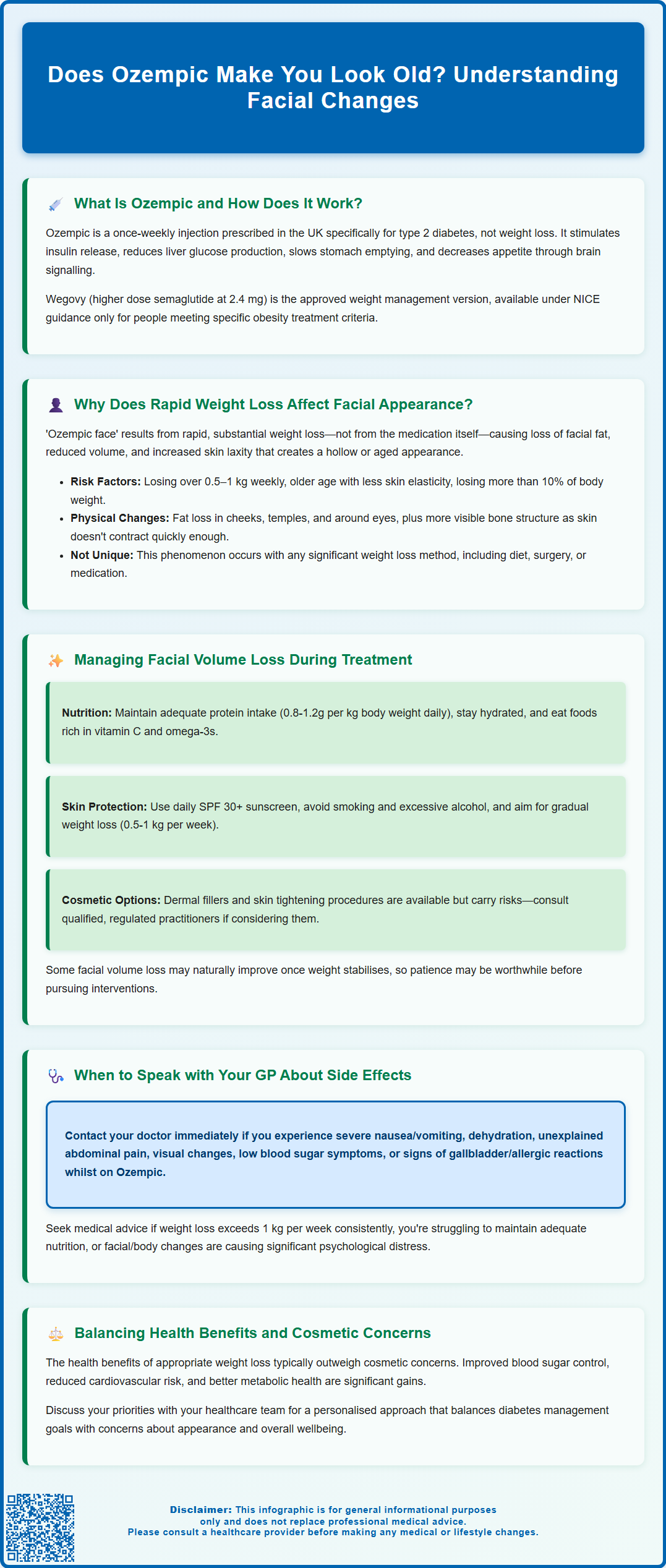Wegovy®
A weekly GLP-1 treatment proven to reduce hunger and support meaningful, long-term fat loss.
- ~16.9% average body weight loss
- Boosts metabolic & cardiovascular health
- Proven, long-established safety profile
- Weekly injection, easy to use

Ozempic (semaglutide) is a GLP-1 receptor agonist licensed in the UK for type 2 diabetes management. Whilst effective for glycaemic control, some people notice facial changes during treatment—often described as 'Ozempic face'. This appearance change is not caused by the medication itself, but results from rapid, substantial weight loss that reduces facial fat volume. Similar changes can occur with any significant weight reduction, whether through medication, diet, or surgery. Understanding why these changes happen and how to manage them can help you balance the important metabolic benefits of treatment with cosmetic concerns.
Summary: Ozempic does not directly cause ageing, but rapid weight loss from the medication can reduce facial fat volume, creating a more hollow or gaunt appearance sometimes called 'Ozempic face'.
Ozempic (semaglutide) is a prescription medicine licensed in the UK for the treatment of type 2 diabetes mellitus. It belongs to a class of drugs called glucagon-like peptide-1 (GLP-1) receptor agonists, which work by mimicking a naturally occurring hormone that regulates blood sugar levels and appetite.
The mechanism of action involves several key processes:
Stimulating insulin secretion from the pancreas when blood glucose levels are elevated
Suppressing glucagon release, which reduces glucose production by the liver
Slowing gastric emptying, helping you feel fuller for longer
Acting on appetite centres in the brain to reduce hunger and food intake
Ozempic is administered as a once-weekly subcutaneous injection and is available in pre-filled pens. Treatment typically begins at 0.25 mg weekly for 4 weeks as a starting dose for tolerability, then increases gradually to minimise gastrointestinal side effects. Maintenance doses for glycaemic control are 0.5 mg, 1 mg, or 2 mg weekly.
Whilst Ozempic is specifically licensed for diabetes management, it has gained considerable attention due to its significant weight loss effects. It's important to note that Ozempic is not licensed for weight management in the UK. For obesity treatment, Wegovy (also semaglutide, but at a higher 2.4 mg dose) is the specifically licensed product, available under NICE guidance (TA875) for people meeting specific eligibility criteria. The Medicines and Healthcare products Regulatory Agency (MHRA) continues to monitor the safety profile of semaglutide products.

The phenomenon sometimes referred to as 'Ozempic face' is not a direct pharmacological effect of semaglutide itself, but rather a consequence of rapid and substantial weight loss. There is no evidence that semaglutide has a direct effect on skin ageing at a cellular level; instead, the changes observed relate to the loss of facial volume that can occur with significant weight reduction.
When individuals lose weight quickly, several physiological changes affect facial appearance:
Loss of subcutaneous fat in the face, particularly in the cheeks, temples, and around the eyes
Reduced facial volume that previously provided structural support and a youthful contour
More prominent skin laxity, as the skin may not contract quickly enough to match the reduced underlying tissue
Increased visibility of underlying bone structure, which can create a more hollow or gaunt appearance
These changes are more pronounced in individuals who:
Experience rapid weight loss (generally more than 0.5–1 kg per week, which exceeds NHS recommended safe rates for many people)
Are older, as skin elasticity naturally decreases with age
Lose a substantial total amount of weight (typically more than 10% of body weight)
Have pre-existing reduced skin elasticity due to factors such as sun damage or smoking
It is important to emphasise that these facial changes can occur with any form of significant weight loss, whether achieved through medication, dietary modification, bariatric surgery, or other means. The effect is not unique to Ozempic or other GLP-1 receptor agonists. Gradual, steady weight loss may help reduce, but not necessarily eliminate, these cosmetic concerns whilst still achieving important metabolic health benefits.
If you are experiencing facial volume loss whilst taking Ozempic or undergoing any weight loss treatment, several strategies may help support skin health, though they may not prevent all facial volume changes.
Nutritional approaches to consider:
Focus on adequate protein intake from food sources (generally 0.8–1.2g per kg of body weight daily, depending on individual needs)
Maintain appropriate hydration based on your needs and medical conditions
Include foods rich in vitamin C and omega-3 fatty acids as part of a balanced diet
Discuss with your GP or a dietitian whether a multivitamin supplement is appropriate if your dietary intake is restricted
Note: If you have kidney disease, heart failure, liver disease or are pregnant, speak with your healthcare team before making significant changes to protein or fluid intake.
Lifestyle measures that may support skin health include:
Sun protection with daily SPF 30+ sunscreen to prevent further collagen breakdown, as recommended by NHS guidance
Avoiding smoking and excessive alcohol, both of which can affect skin health
Gradual weight loss where possible (0.5–1 kg per week is generally recommended by the NHS)
Medical and cosmetic interventions that some people consider:
Dermal fillers containing hyaluronic acid can temporarily restore facial volume, but carry risks including infection, vascular complications, and asymmetry
Skin tightening procedures such as radiofrequency or ultrasound therapy have variable evidence for effectiveness
Consultation with a dermatologist for personalised skincare recommendations
If considering cosmetic procedures, ensure you use appropriately qualified, regulated practitioners and understand all potential risks and costs involved.
It is worth noting that some facial volume loss may naturally improve over time as weight stabilises. The metabolic and cardiovascular benefits of appropriate weight loss typically far outweigh cosmetic concerns, but discussing your priorities with your healthcare team ensures a balanced approach to treatment.
Whilst facial volume loss is generally a cosmetic concern rather than a medical emergency, there are several situations where you should contact your GP or diabetes specialist nurse regarding Ozempic treatment.
Seek medical advice if you experience:
Severe or persistent nausea and vomiting that prevents adequate food or fluid intake
Signs of dehydration, including dark urine, dizziness, or reduced urination (this can potentially lead to acute kidney injury if severe)
Unexplained abdominal pain, particularly severe pain in the upper abdomen that may radiate to the back (potential pancreatitis)
Visual changes or symptoms of diabetic retinopathy worsening
Symptoms of hypoglycaemia (low blood sugar), especially if taking Ozempic alongside other diabetes medications
Right upper abdominal pain, fever or yellowing of the skin/eyes, which could indicate gallbladder problems (cholelithiasis or cholecystitis)
Allergic reactions, including rash, itching, or swelling
Regarding weight loss and appearance concerns, contact your GP if:
Weight loss is excessively rapid (more than 1 kg per week consistently)
You are experiencing significant nutritional deficiencies or difficulty maintaining adequate nutrition
Facial or body changes are causing significant psychological distress
You wish to discuss adjusting your treatment plan to slow the rate of weight loss
Importantly, do not abruptly reduce or stop insulin if you are also using insulin therapy, as this could lead to diabetic ketoacidosis. Any insulin adjustments should be guided by your healthcare team.
Your GP can review your overall treatment plan, assess whether dose adjustment is appropriate, and refer you to relevant specialists if needed. According to NICE guidance, regular monitoring during GLP-1 receptor agonist treatment should include assessment of weight, glycaemic control, and tolerability.
If you experience any suspected side effects from Ozempic, you can report them via the MHRA Yellow Card scheme (yellowcard.mhra.gov.uk or via the Yellow Card app).
Remember that the primary goal of Ozempic is diabetes management and metabolic health improvement—your healthcare team can help balance these clinical benefits with your personal concerns about appearance and wellbeing.
No, 'Ozempic face' is not a direct pharmacological effect of semaglutide. It results from rapid, substantial weight loss that reduces facial fat volume, and similar changes can occur with any significant weight reduction regardless of method.
Some facial volume loss may naturally improve over time as weight stabilises. Medical options include dermal fillers or skin tightening procedures, though these carry risks and should be discussed with appropriately qualified practitioners.
Do not stop Ozempic without consulting your GP or diabetes specialist. The metabolic and cardiovascular benefits typically outweigh cosmetic concerns, but your healthcare team can help adjust your treatment plan to balance clinical benefits with your personal wellbeing.
The health-related content published on this site is based on credible scientific sources and is periodically reviewed to ensure accuracy and relevance. Although we aim to reflect the most current medical knowledge, the material is meant for general education and awareness only.
The information on this site is not a substitute for professional medical advice. For any health concerns, please speak with a qualified medical professional. By using this information, you acknowledge responsibility for any decisions made and understand we are not liable for any consequences that may result.
Lorem ipsum dolor sit amet, consectetur adipiscing elit, sed do eiusmod tempor incididunt ut labore et dolore magna aliqua. Ut enim ad minim veniam, quis nostrud exercitation ullamco laboris nisi ut aliquip ex ea commodo consequat. Duis aute irure dolor in reprehenderit in voluptate velit esse cillum dolore eu fugiat nulla pariatur.
Block quote
Ordered list
Unordered list
Bold text
Emphasis
Superscript
Subscript